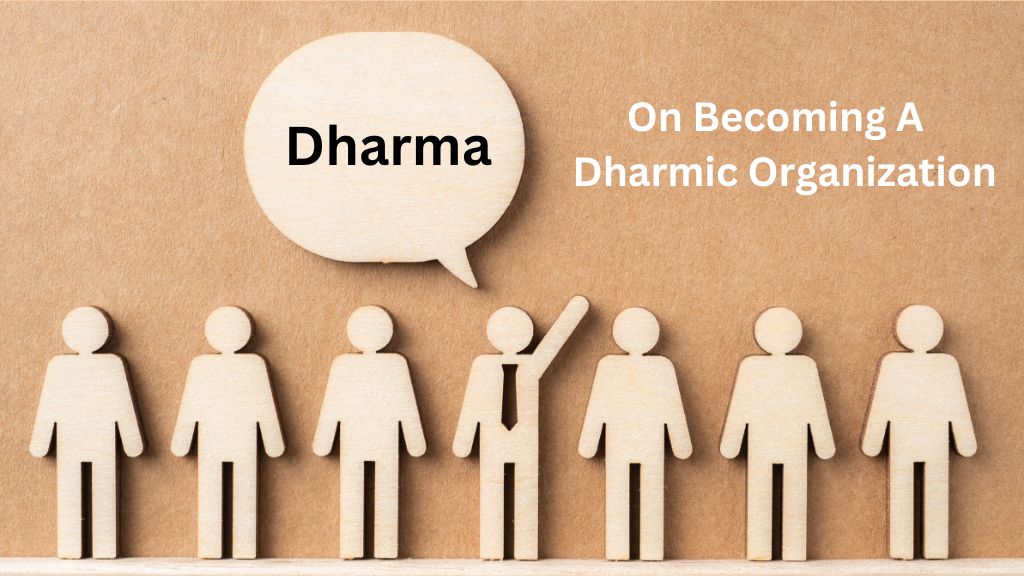A Broad Overview on How An organization Can Become Dharmic
धारणाद् धर्म इत्याहुर्धर्मो धारयते प्रजाः | यत् स्याद् धारणसंयुक्तं स धर्म इति निश्चयः || (Maha. Karna. 69-58)
dhāraṇād dharma ityāhurdharmo dhārayate prajāḥ | yat syād dhāraṇasaṃyuktaṃ sa dharma iti niścayaḥ || (Maha. Karna. 69-58)
Meaning: Dharma sustains the society, Dharma maintains the social order, Dharma ensures the well-being and progress of humanity. Dharma is surely that which fulfills these objectives. Therefore, Dharma embraces every type of righteous conduct, covering every aspect of life essential for the sustenance and welfare of the individual and society. It includes those rules which guide and enable those who believe in a supreme force and higher worlds to attain Moksha.
सत्यं हि परमं धर्मं धर्मं धारयते प्रजाः।
Satyaṁ hi paramaṁ dharmaṁ dharmaṁ dhārayate prajāḥ.
Meaning: “Truth is the highest Dharma, and Dharma sustains the people.” – from the Mahabharata
In today’s fast-paced corporate landscape, businesses are increasingly called upon to balance profitability with ethical responsibility. Organizations must align with sustainable practices, transparency, and ethical leadership while also ensuring long-term success. The Integrated Dharmic Framework for Business, inspired by ancient Indic wisdom, provides a structured approach to ethical and sustainable business conduct. By embedding Dharma—the principle of righteousness—into the core of business operations, organizations can cultivate integrity, accountability, and holistic success.
A truly Dharmic organization recognizes that its very existence is tied to Loka Sangraha, the collective well-being and upliftment of society. It does not see itself as a separate entity but rather as an integral part of the larger ecosystem. This perspective fosters a deep sense of responsibility and innovation in fulfilling its Dharmic purpose.
An existing organization can begin this transformation by examining every aspect of its existence and operation and determining whether it contributes to Loka Sangraha—social welfare—or not. It must evaluate whether any of its operations, activities, products, or services cause harm to society or the world in any way. This deep self-inquiry is the first step toward aligning itself with Dharma.
Additionally, a Dharmic organization must replace a rules-based ethical framework—which is common in industry—with a Dharmic ethical framework. This framework should be based on a combination of ethical principles, Dharma, and the incorporation of practices that bring these principles alive, making them living principles embedded in the fabric of the entire organization. By doing so, ethics are no longer mere compliance measures but deeply internalized and actionable guidelines that shape decision-making at every level.
1. Establishing the Foundational Pillars of Dharma in Business
The Dharmic framework rests on four essential pillars that guide ethical decision-making and behavior within an organization:
A. Alignment with Inner Nature and Duty (Svabhava and Svadharma)
Individuals must operate in alignment with their innate strengths and responsibilities. Organizations should facilitate this alignment to ensure employees thrive in roles that best suit their talents.
Implementation:
Conduct regular self-assessment and career reflection programs.
Align employees’ responsibilities with their natural aptitudes and interests.
Foster an environment where employees can contribute meaningfully and purposefully.
B. Discernment (Viveka)
Discernment involves making well-informed, ethical decisions that balance practical needs with moral imperatives. Dharmic organizations need leaders who have “Dharmic Drishti” (Dharmic vision) and use “Dharmic Buddhi” (Dharmic intellect) along with Viveka to guide their decision-making.
A key step in an organization becoming Dharmic is the activation of the Dharmic compass of its key leaders. This transformation can be achieved through a detailed process in which their current mental models are examined through a Dharmic lens. By guiding them through a systematic process, they develop a new perspective—a Dharmic Drishti. Once this transformation occurs, the organization needs someone already deeply steeped in Dharmic thought and logicto serve as a guiding force. This individual can help steer decision-making step by step, ensuring that every business choice moves the organization toward Dharma.
C. Truth and Cosmic Order (Satya and Rta)
Transparency and harmony with the greater good ensure that businesses operate with integrity, benefiting all stakeholders.
D. Justice and Universal Ethics (Nyaya and Samanya Dharma)
Fairness and integrity must be the foundation of business operations, ensuring justice in all dealings.
2. Applying Dharmic Values to Key Organizational Stakeholders
For Leaders and CEOs: Ethical Leadership (Rajadharma)
For Managers: Fostering a Dharmic Workplace Culture
For Employees: Personal Duty (Svadharma)
For Vendors: Ethical Partnerships
For Customers: Transparency and Value-Driven Engagement
3. Expanding Awareness of Stakeholders
A Dharmic organization must consider a broader field of stakeholders, including animals, birds, rivers, mountains, and even non-living ecosystems.
Implementation:
Conduct impact assessments that account for ecological, social, and economic factors.
Develop policies that minimize harm to all living and non-living stakeholders.
Foster an organizational culture that sees itself as a guardian of collective well-being.
4. Dharma and Profitability: A Balanced Approach
A Dharmic organization does not reject profitability—instead, it recognizes that Dharmasya Moolam Artha (the root of Dharma is prosperity). However, it prioritizes life and the well-being of the largest pool of stakeholders over mere financial profit. It approaches this as a design challenge, ensuring that both stakeholder well-being and shareholder well-being are achieved—with stakeholder well-being coming first.
Implementation:
Foster ethical innovation to achieve both profit and social good.
Integrate sustainability-driven business models that ensure long-term viability.
Recognize that the organization’s prosperity is directly tied to the well-being of the society in which it operates.
Conclusion: A Living Dharma
Being a Bharatiya (Indian) organization is not just about stating values but living those values—decision by decision, action by action. The adoption of a Dharmic vision inspires organizations to become ethically innovative in fulfilling their higher purpose. A Dharmic business sees the society as its family, integrating itself into the fabric of collective well-being. By committing to Dharma in every aspect of its operations, an organization not only thrives in a competitive marketplace but also leads the way in shaping a more just, sustainable, and harmonious world.








Welcome https://vk.com/clip-229128076_456239434
Your insights are visionary! Have you explored Sprunki Phase? It’s visionary art.